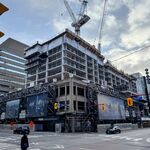unimaginative2
Senior Member
Rainwater proposed to flush Ex toilets
JEFF GRAY
The Globe and Mail
November 29, 2007
Plans to spend nearly $1-million on a "demonstration rainwater harvesting system" at Exhibition Place are a waste of money, critics say, but city officials argue the move will yield long-term environmental benefits.
With little debate, the city's works committee recommended yesterday that council approve the plans, which would see rainwater collected at the Automotive Building and then used to flush toilets in its eight washrooms, as part of a pilot project to showcase new technology to make buildings more efficient.
Toronto Water would put up $600,000 in its capital budget for the project, while city-owned Exhibition Place would pick up the rest of the bill, expected to be a total of up to $935,000, as part of the Automotive Building's renovations.
The works committee chairman, Councillor Glenn De Baeremaeker, an ally of Mayor David Miller, said the project would inspire others in the city to install similar systems, reducing the amount of cleaned and filtered drinking water wasted on flushing toilets.
"It's a great technology that we want to demonstrate to the world," Mr. De Baeremaeker (Scarborough Centre) said yesterday, arguing that widespread adoption of the technology would conserve water, save energy and spare the city millions of dollars by delaying the need for new water-filtration plants.
Critics disagreed that the cash-strapped water department, which has been raising rates at least 9 per cent a year to pay for the replacement of rusting and breaking pipes, should be spending any extra money on such a project.
"It's another example of the city wasting money on a non-priority," said Councillor Denzil Minnan-Wong, a right-leaning critic of the mayor.
He said in an interview that the private sector is already adopting new green technologies that save companies money and meet customer demands, without government interference.
"Governments don't have to waste money on these kinds of projects to show that they work," said Mr. Minnan-Wong (Don Valley East).
Even Councillor Adam Vaughan, a left-leaning independent, was critical.
"It's a lot of money for eight washrooms," he said.
While acknowledging that many environmental initiatives at Exhibition Place are good ideas, Mr. Vaughan (Trinity Spadina) said the Ex recently refused to give local Muslims a break when renting a room for Eid celebrations, even as it decides to spend lots of money on other projects.
"Instead of standing up for large engineering firms, the CNE needs to serve the needs of individual Torontonians," said Mr. Vaughan.
A similar rainwater collection system was proposed for Exhibition Place's Better Living Centre.
JEFF GRAY
The Globe and Mail
November 29, 2007
Plans to spend nearly $1-million on a "demonstration rainwater harvesting system" at Exhibition Place are a waste of money, critics say, but city officials argue the move will yield long-term environmental benefits.
With little debate, the city's works committee recommended yesterday that council approve the plans, which would see rainwater collected at the Automotive Building and then used to flush toilets in its eight washrooms, as part of a pilot project to showcase new technology to make buildings more efficient.
Toronto Water would put up $600,000 in its capital budget for the project, while city-owned Exhibition Place would pick up the rest of the bill, expected to be a total of up to $935,000, as part of the Automotive Building's renovations.
The works committee chairman, Councillor Glenn De Baeremaeker, an ally of Mayor David Miller, said the project would inspire others in the city to install similar systems, reducing the amount of cleaned and filtered drinking water wasted on flushing toilets.
"It's a great technology that we want to demonstrate to the world," Mr. De Baeremaeker (Scarborough Centre) said yesterday, arguing that widespread adoption of the technology would conserve water, save energy and spare the city millions of dollars by delaying the need for new water-filtration plants.
Critics disagreed that the cash-strapped water department, which has been raising rates at least 9 per cent a year to pay for the replacement of rusting and breaking pipes, should be spending any extra money on such a project.
"It's another example of the city wasting money on a non-priority," said Councillor Denzil Minnan-Wong, a right-leaning critic of the mayor.
He said in an interview that the private sector is already adopting new green technologies that save companies money and meet customer demands, without government interference.
"Governments don't have to waste money on these kinds of projects to show that they work," said Mr. Minnan-Wong (Don Valley East).
Even Councillor Adam Vaughan, a left-leaning independent, was critical.
"It's a lot of money for eight washrooms," he said.
While acknowledging that many environmental initiatives at Exhibition Place are good ideas, Mr. Vaughan (Trinity Spadina) said the Ex recently refused to give local Muslims a break when renting a room for Eid celebrations, even as it decides to spend lots of money on other projects.
"Instead of standing up for large engineering firms, the CNE needs to serve the needs of individual Torontonians," said Mr. Vaughan.
A similar rainwater collection system was proposed for Exhibition Place's Better Living Centre.
















